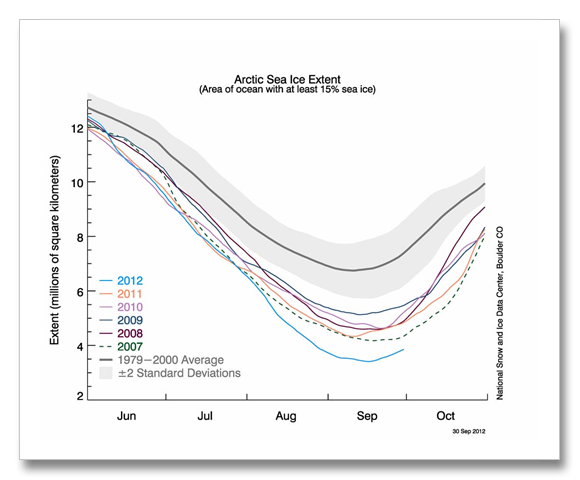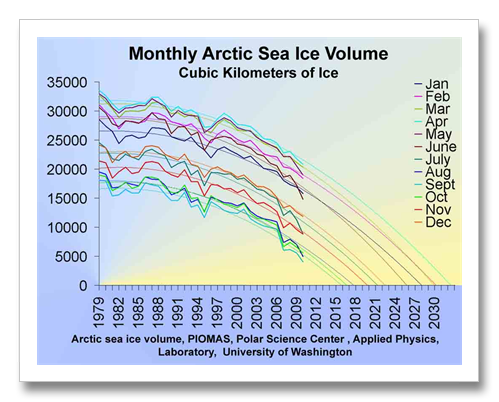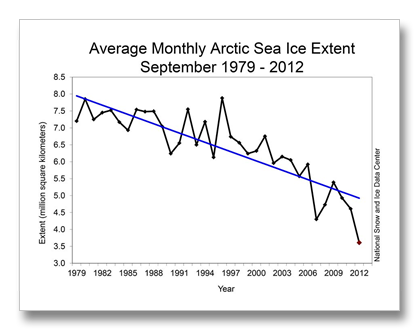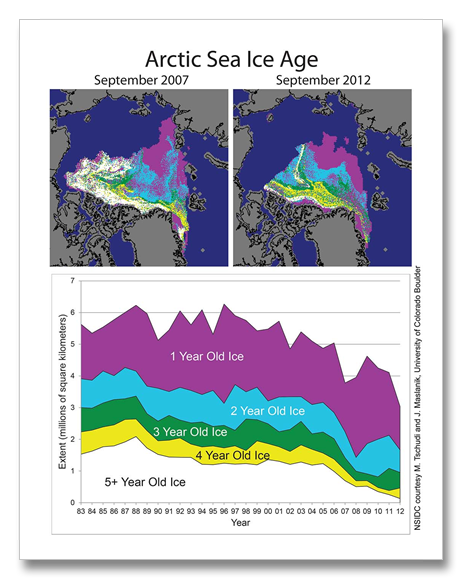Arctic sea ice has smashed its last smashed record by a margin nearly as great as the previous smashing.
The minimum Arctic sea ice record set in 2007 was widely believed to be a freak, caused by freak weather conditions. It shattered the previous record by 22 percent. This year’s record shattered the 2007 record by 18 percent. Bigger yet, this years record shattering comes after an “average” summer and the Barents and Kara Seas temps were even cooler than normal. Contrast this with 2007 when temps were much warmer than normal and wind conditions bunched up the ice and pushed it out of the Arctic into the Greenland Sea.
Maslowski’s prediction is coming true (see September 10, 2010). Arctic sea ice is in a freefall and we will see ice free conditions in the summertime in the Arctic before 2020 (right click images for larger versions). In reality, summer sea ice in the Arctic is so rotten in mid summer now that it is no impediment to shipping (see also September 10, 2010).
Avery important piece of climate science kicks in now that there is so much more open water in the Arctic. It’s the open Arctic ocean feedback. What this does is it supercharges the winter atmosphere with moisture while the Arctic Ocean has yet to freeze over. And the lower the extents record in the fall, the longer the Arctic Ocean stays open into the following winter. Year before last it set the longest open water record extending into January before ice up–a full month longer than ever before recorded.
All of this energy in the form of heat and water vapor creates berserk weather patterns that shift Arctic weather further south on the jet stream as we saw in 2005/6, 2007/8 and 2009/10 and 2010/11. Even though warm for Arctic standard, theses blizzards are still way cold for us down here in the States. (See February 10, 2010 and December 10, 2010)
So my first prediction for a near-term extreme climate change caused weather event is (are) snowpocalypses and snowmeggedons blizardaroos and what was it it–total devicestation. just wait till we get the big bad-ass ice storm that puts the Canadian ice storm of 1998 when 5 inches accumulated in some places, to complete shame. Expect the berserk winter weather in the U.S Northeast, Northeast Canada and Northern and Central Europe. Freak winter weather could show up anywhere, but these seem to be the preferred areas.
So we had “normal” to colder than normal weather this summer with no abnormal winds pushing the ice around like crazy and we still smashed the previous record to smash all records. Why is this? It’s because of the feedback. Normal winter conditions in the Arctic will grow about 6 feet of ice per winter. As the ice thickens, the relatively warm ocean below keeps it from getting much thicker faster. But every year it can add six feet if it does not melt. Here’s the problem: lots of ice is melting every year, far more than normal.
Since just before the turn of the century we have been melting more ice every summer than can be replaced every winter. It’s a chain reaction. Less sea ice in the summer means longer till freezeup in the winter, which allows less time to grow thick winter ice, which melts more rapidly every summer because it is thinner, which allows more heat to build up in the Arctic Ocean every winter, which further increases the time to freezeup and the dance continues in a replicating spiral that falls faster and faster every year until BOOM! It’s all gone.
The results are that not only is Arctic sea ice coverage at an all-time low, but Arctic sea ice volume is at an all time low too. Look at the graphic titled Arctic Sea Ice Age. It’s easy to see the domino effect in action here. Every year it get’s warmer, or almost every year. The warming feeds back into less ice in winter which dominoes into a longer open water summer season which warms more ocean water pushing freezeup farther and farther into winter.
Looking at how strange these winters have been lately, we had a snowtastic year in 2004 in Texas when we saw a big snowstorm on the Texas coast. Eight inches of snow fell in my favorite place to get into the coastal Texas wilderness by boat: Port O’Connor. Victoria, about 40 miles north of Port O’Connor, had 18 inches. The year 2004 had the tenth lowest sea ice extents measured in the Arctic since record keeping began in 1979. 2002 was the ninth lowest. Every year since 2004 has seen a lower sea ice coverage than 2002. The year 2003 was only slightly higher than 2002 and 2004.
This storm was a rarity indeed. It was the first time in recorded history for almost every recording station on the Texas coast to have a white Christmas. In Victoria and Corpus, their 13 and 5.2 inch totals respectively were more than all previous snowfalls since the 19th century combined. Brownsville had 1.5 inches, more than any snow event there in 105 years.
If these extreme events were to never happen again the deniers and delayers would be correct: climate change would be a hoax. But the high temperature records continue to recur at a rate that is twice as frequent as low temperature records. Arctic sea ice continues its fall over the brink. Greenland’s 97 percent surface melt may have been similar to events over the last 2,000 years that happen every 80 to 300 years, but now we have been told by some of the smartest people in the world that our climate has changed.
They have been telling us for 20 years that our climate would change if we did not reduce emissions, and the longer we delayed the quicker the changes would come, the more extreme would be those changes and the faster our would climate change in the future.
As just one example, Arctic sea ice is disappearing 70 years ahead of schedule and the list of other climate change impacts already happening far ahead of schedule is long and wearisome. The image below is based on the 2007 record. This years record was 3.61 million square kilometers. On the graph below this is 4.89 million square kilometers below the 0.0 arbitrary baseline.
And as a corollary-Antarctic Sea Ice; this year we again saw a record in Antarctic sea ice only it’s another maximum sea ice record. What you say? Shouldn’t Antarctic sea ice be shrinking on a warmer planet? I’ve written about this several times. Because the Antarctic is land surrounded by sea vs. sea surrounded by land at the North Pole, climate change affects the South Pole differently. Temperatures down there are stable to slightly rising, nowhere near approaching melt across such a large area as Greenland saw this year, but other aspects of the climate down there have changed.
The winds have increased and changed in direction somewhat. among many other things, this spreads the ice out farther, increasing sea ice coverage–even on a warmer planet. It’s just that Antarctica is soooo dang cold, a little warming doesn’t mean much. BUT! The higher winds are is mixing more warmer water with the frigid Southern Ocean water. Ice loss in Antarctica has caught up with that in Greenland simply because the oceans are warmer down there now. Much of the ice loss in the Antarctic is now coming from the bottom of ice shelves that are much more numerous down yonder than at the North Pole. In the 2007 IPCC though, Antarctica was not supposed to start losing ice until beyond the end of the 21st century. Snowfall on the interior of Antarctica (on a warmer planet–remember that warmer air holds more moisture) was supposed to counteract melting around the edges caused by warming. But this has not happened. The melt from below the ice is strong. Antarctica wasn’t even supposed to start losing ice until after 2100. Unbelievable!
See Previous Discussions:
October 7, 2011–Unprecedented Arctic Ozone Destruction
July 15, 2010 Five Big All-time Global Climate Records Broken in June
December 2, 2009 Antarctic Melt Increases While the Ozone Hole Keeps it Cool
National Snow and Ice Data Center: http://nsidc.org/arcticseaicenews/





